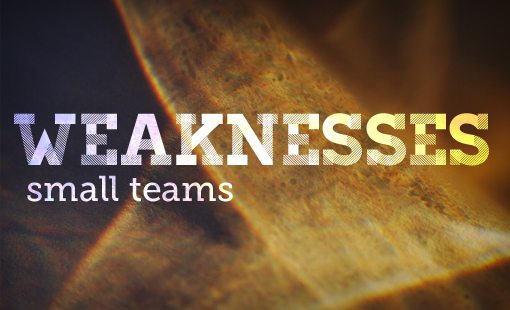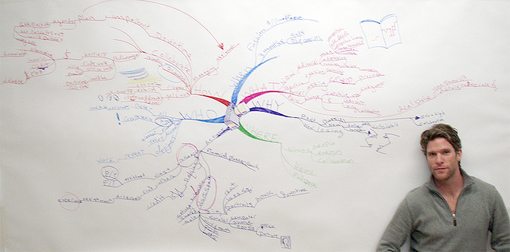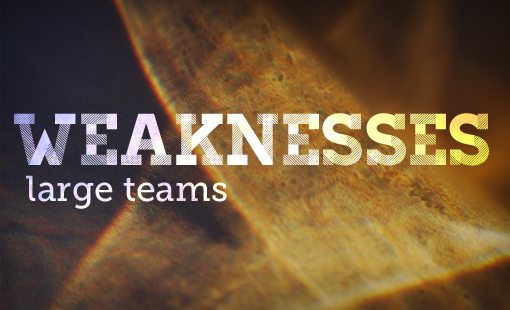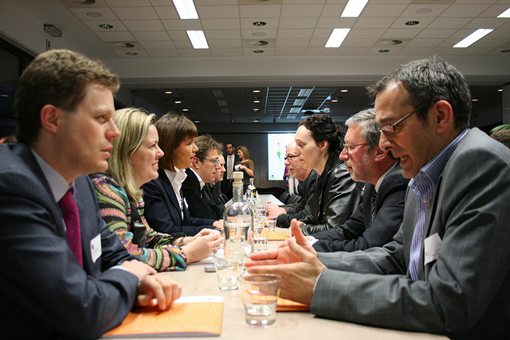Know Your Weaknesses: How to Improve Your Creative Review Process
Every designer has to answer to someone. Freelancers turn their work in to a client, company guys hand theirs over to a team or supervisor, there’s always someone next in the chain of command that gets to take a look and offer an opinion. It’s at this point that the initial draft ends and the creative review begins.
This critical point can have a dramatic effect on the future of the project. Sometimes this is a good process that takes the piece to new heights that it could’ve never reached without some fresh insight. Other times the creative review process kills the genius of the initial draft and results in a misguided final product. One factor that plays a key role in this is the size of the review team. How many people should review a design and offer ideas? Should it be a small team? What are the pros and cons of each? Let’s discuss.
Strengths and Weaknesses
Most of us have within us a biased that leans towards how we think a creative review should be structured. Some designers are very social and love to get as much feedback as possible from as many sources as possible. Others prefer to spend their days completely alone at their desk and hate it when someone second guesses what they’ve worked hard to achieve.
The most obvious question to posit is of course, “Which way is better?” If you have complete freedom to construct a creative review process, which way should you go?
Unfortunately, the answer isn’t as black and white as we’d like it to be. The truth is, every possible scenario has been tried and most can be clearly shown to lead to both amazing successes and embarrassing failures.
The most important thing that you can do to refine your creative review process is to discover and acknowledge the strengths and weaknesses of each possibility, and then attempt to account for these by leveraging the strengths and finding ways to counter the weaknesses.
Let’s take a look at how this process works by examining small and large team creative reviews.
Strengths: Small Teams

The power of the individual should never be underestimated. Free from the bonds of compromise, lone wolf freelancers can turn out stunning work.
Working alone allows you to “get in the zone” and really carry ideas out through to completion with masterful and focused execution. No one is there to make you second guess your choices or to tell you that their ideas are better. It’s just you, a blank canvas and the completely unimpeded flow of ideas.
Remember that we’re not discussing the work itself though so much as the review process. The only time you’ll ever have a single person be the only pair of eyes on a project from start to finish is if the creative is working on a personal project. Otherwise, the review process involves at least the designer and the client, the latter of which is typically comprised of numerous people.
Small groups can be great for creative reviews. Here are just a few of the strengths of this form of review. Keep in mind that these are all best case scenarios. Throw the wrong person into the mix and every one of these benefits can instantly disappear.
Focused Feedback
The feedback from small groups is typically much more focused. Instead of a room full of people blurting out random observations and ideas that lead to longwinded tangents, you have a couple of people really honing in on the creative at hand and exploring how it could be better.
Shorter Meetings
Meetings are meant to be a productivity booster, but in the real world nothing kills productivity faster than everyone ceasing work to sit around a table and chat for a few hours while deadlines approach.
With small teams, creative reviews can be quick and efficient. You can get everyone in the room or on the phone much quicker, the pleasantries and greetings are fast and easy and, as we just stated, the feedback is less tangential.
Agreements Are Easier to Reach

One of the primary strengths of a small team of reviewers is the ability to reach agreements for both how to improve the work and reach the conclusion that the project is good enough to move along to the next step.
This can make projects go smoother and result in a more cohesive and coherent end result. When there are disagreements, resolutions are approached quickly and handled directly.
Weaknesses: Small Teams

Thus far, small teams sound like the way to go don’t they? There’s so much good that can come from a tight knit group of a couple of designers, why would you ever have anything else?
Unfortunately, the small creative review team format comes with its share of downsides as well. Here are a few of the major hurdles.
Mistakes Are Easy to Miss
The first problem that arises with a very small creative review team is that mistakes are often missed. If you get ten to twenty people looking at the same thing, they’ll tear it apart and notice every little error: a photo that wasn’t licensed properly, a spelling mistake, alignment issues, a website element that isn’t functioning, etc. However, these things are easily looked over when you only have a couple of people pouring over a project.
Idea Pool is Less Varied
Another obvious downside to having a smaller team of reviewers is that there will be fewer ideas being tossed about for how to improve the creative. As we mentioned above, this can in fact be a strength if you’re on a deadline and need to move the process along, but it can also be a serious weakness if you’ve reached a point where you know that the creative could be better but no one really has a solid idea for how to get it there.
This often leads to a “good enough” mentality, which results in shoddy, second rate work being produced.
Less Pushback Leads to Groupthink
If you put enough people in a room, you’re bound to come across a squeaky wheel; someone who complains about everything. In a smaller setting, the desire for harmony and agreement is more prevalent.
This sounds like a good thing but in practice it can lead to a phenomenon called “groupthink” where a particular group of people allows the desire for agreement to override the good of the project.
The result is less creativity and unique thinking, which is obviously counterproductive in a “creative review process.” This is the place where you want crazy ideas and out of the box feedback, not a group of people who are just trying to get along.
Strengths: Large Teams

Countless major marketing and design firms choose this format for creative review. They come together in a big meeting to launch a project, send everyone off in small teams to produce some creative and then meet back later as a large group to discuss and critique what was produced.
If you read through the weaknesses of small teams, then it’s easy to come up with some strengths for the larger teams as they’re often the direct opposite.
Mistakes and Weaknesses Are More Likely to Be Addressed
I used to be part of a two man creative team. We once worked on a project together that featured, for whatever reason, the silhouette of a dog as the main graphic. One of us produced a quick silhouette and we proceeded to put it on several pieces of creative. Having seen the original photo that was converted to a silhouette, we both thought it looked just perfect.
When we turned the creative into our immediate supervisor, it went over very well. However, once we reached the point of a large team review, someone made note that the silhouette bore an unfortunate resemblance to a male body part. Several people had seen this creative before this point and thought nothing of the sort, but as soon as one person pointed it out, no one could deny that it was indeed the horrible truth and the creative had to be revised.
The moral here is that large groups of people tend to catch the important mistakes that can easily be looked over by a small group. If the project above had been reviewed by only our small group, it would’ve gone to print and no doubt horrified hundreds of thousands of viewers (it was to go in major retail stores everywhere).
More Ideas and Feedback

Obviously, with a larger creative review team, there are bound to be a bunch more discussions for how the creative can be improved. The more people that look at a piece of creative the greater the odds of finding someone who doesn’t like it.
Remember that the goal for creative review isn’t always for everyone to give you a thumbs up and a pat on the back. If you want this you can show your artwork to your mother so she can put it on her refrigerator.
Instead, what you’re looking for is professional criticism that can lead you to true improvement. Quality feedback is hard to find but when you do find come across it, you instantly realize that it’s an invaluable piece of the creative process.
Division of Labor
Large review teams, when run well, can divide and conquer when it comes to the parts of the creative that need to be discussed. Instead of having one or two people troubleshoot everything (or having everyone offer advice outside their area of knowledge), you can have everyone focus on what they’re good at.
For instance, some people can focus on examining the usability of a web page to make sure all the processes are streamlined while others evaluate the graphical and aesthetic side to ensure that the project is heading in the right direction from a visual perspective.
Weaknesses: Large Teams

There’s an old adage that you’ll hear far too often from people in favor of large review teams “two heads are better than one.” Even if this is often a true statement, it turns out that it’s not always the case that twenty heads are better than four. Here are some things to watch out for with large creative review teams.
Reduced Quality of Feedback
As with many things in life, here you’ll find that there’s often a tradeoff between quality and quantity. Give one person a look at the project that you’re working on and you’re likely to get a few clearly focused responses. That person may miss 60% of what’s wrong with the piece, but he/she has the potential to really make a convincing case for the feedback that was presented.
Now try the same with a room full of people. Suddenly, the feedback is all over the map. No one is on the same page, every person has their own ideas that directly contradict those being offered by everyone else. It can be a real mess!
A System That Bleeds With Inefficiency
Large creative reviews are extremely prone to inefficiency. Too many heads pulling together on too few projects leads to a system where nothing ever gets done.
I’ve personally seen large creative teams that take months to produce a simple, single page ad that gets rejected by the client and then turned over to a team of one or two creatives that churn out a perfect finished product in a matter of hours that the client eagerly accepts.
The problem here isn’t necessarily the talent of the individual designers, instead it’s the simple fact that the creative review process can easily become a hindrance to progress.
When a large group of people critique a project, the original goals and ideas can quickly become lost in a cacophony of voices who just want to have their ideas heard so they can feel important. The result is a mess of compromises that lacks a solitary vision.
Group Dissonance

A related problem with large group creative reviews is that they frequently result in competitive subgroups being formed, each with its own agenda that is separate from the good of the whole.
This results in bureaucracy, bickering and other forms of counterproductive anti-communication that ultimately hurt the quality of the finished project.
Finding the Middle Ground
As we can clearly see, both small and large creative review teams have inherent strengths and weaknesses. An advocate of one can easily condemn the other, but doing so requires ignorance in the flaws of their own methodology.
The purpose of this article is not to reach the ultimate conclusion that both ways suck equally and all we can do is make the best of what we have. Instead it’s to make you realize that there is no magic format that will suddenly make everything better. It’s easy to fall into the “grass is greener” trap and imagine that all of your creative review problems would disappear if you could only change the size of the team.
The real takeaway here is that you need to experiment to see which system makes the most sense for your project or company and then to acknowledge both the strengths and weaknesses of the format that you’ve chosen. Once you can anticipate the problems that you’re going to run into, you can begin to account for them. If you know long meetings are going to kill your team’s productivity, set a time limit. If you know that your small team is prone to make mistakes that are difficult to spot, have some fresh eyes look over the creative from time to time just to be sure you’re not missing anything.
Which Do You Prefer?
Now that you’ve read through our list of strengths and weaknesses for large and small groups of creative review teams, leave a comment below and let us know what your review process is like.
How many people typically critique your work? Do you think your process is ideal or could it be improved? We want to know!
Image Credits: Virginie Moerenhout, Voka Kamer van Koophandel Limburg, Jonny Goldstein, and buddawiggi.